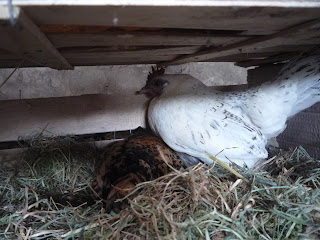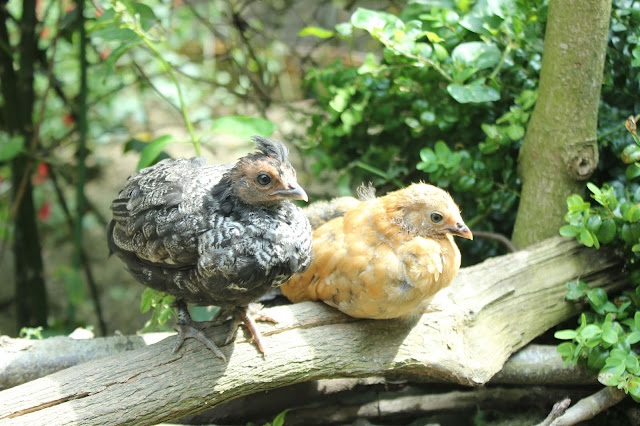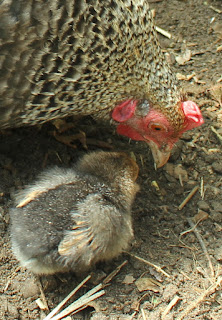"If music be the food of love play on,Give me excess of it:..."
Twelfth Night or What You Will
Act 1, Scene 1
Duke Orsino's reference may fit his mood but I have never found chickens to be particularly swayed by music, particularly my singing. I have however, reasoned over the years that food is the food of love for our birds. Below, Lucky and Co take a postprandial siesta.
For over two decades I’ve been observing the poultry in the garden and noting the marked changes in behaviour and language. This in particular as the flock has expanded and split into smaller sub sets and the garden has transformed into and flourished as a forest. I have always found it fascinating that our birds organised themselves within the 1000m² using the ‘tools’ with which we had sometimes inadvertently provided them. They achieved this using our boundaries, both architectural and planted, to designate territories, achieve extra space, create free movement through leafy corridors and access alternative foraging grounds. Examples of these are; hedges and trees, greenhouses and hen house roofs, rose arches, wilderness areas, pergolas and climbing plants.
 To support and provide some ‘academic’ weight to my ideas about what
has happened to my birds and how they have changed over the years, I study all the fieldwork and research I can find on the various forms
of my poultry’s wild cousins, the Jungle fowl. Most of these
studies took place prior to the latter part of the 20th
century when there still existed significant numbers of Jungle fowl,
living in remote areas and untouched by by both man’s physical intervention
into their domain and the propinquity and thus cross-breeding with domestic poultry.
To support and provide some ‘academic’ weight to my ideas about what
has happened to my birds and how they have changed over the years, I study all the fieldwork and research I can find on the various forms
of my poultry’s wild cousins, the Jungle fowl. Most of these
studies took place prior to the latter part of the 20th
century when there still existed significant numbers of Jungle fowl,
living in remote areas and untouched by by both man’s physical intervention
into their domain and the propinquity and thus cross-breeding with domestic poultry.In this article I want to look at the way in which this return to the wild has impacted upon feeding behaviour and in particular the idea of food as an expression of love and care between parent and young and potential partners, although in the latter this sometimes involves duplicity in the male! To this end, I will include the links I've used from academic research, with which to contrast and compare my own observations. The references can be found in the footnotes at the end of this article for those of you who would like to follow them up.
(Above image: Red Junglefowl G. g. gallus Top Right)
An interesting and certainly seminal work in the field of the behaviour surrounding foraging and feeding is 'Parental and Courtship Feeding in the Red Jungle Fowl'. This was a study carried out by Allen W. Stokes in the late 60's and published in 1971. It is highly appropriate to contrast and compare this work with my own observations because unlike other earlier studies it was carried out within a zoo, San Diego to be precise but on a 'semi-domesticated' but unconfined population of 222 Red Junglefowl. In the same way my birds, could have left our garden at any time, these Junglefowl chose to remain within the designated 40 hectares and as with my birds, divided themselves into small groups or flocks. Interestingly the population was almost equally divided between male and female but in contrast to my hens, who if left to their own devices will produce two hatches per year, the Red Junglefowl produced only one brood, with peak hatching in April. My hens follow the weather and thus the food availability. This year for example, when the early Spring weather was particularly wet and unseasonably cold, my birds didn't nest and sit until Summer.
Parental Feeding
So let's have a look at some of the observations from the paper produced by Stokes:-
'The young gallinaceous birds are precocial but they need help from one or both parents to obtain food during their first few weeks. Typically the parent locates food and behaves in such a way that the young will get it. The parent may let the chick take a morsel from its beak, drop the food in front of the chick or use specific calls to alert the chick to the presence of the food. All these behaviour patterns I include under the term parental feeding.'

Similarly, I have observed joint parental feeding of chicks in my flocks, though rarely by mouth from the male and as the forest has developed the frequency of co-parenting by both male and female behaviour has too, including males helping chicks to roost and keeping them warm at night.
Stokes was very precise in his assessment of how the Redjungle fowl brooded their chicks, he gave exact timelines and detailed stages to parental behaviour:-
'During their first few days after hatching jungle fowl chicks remained within a meter of the hen. When foraging the hen was ever on the move. She shifted the litter with a side- ways sweep of her beak and scratched with her feet. When she found a suitable piece of food during these first days she picked it up, held it above or in front of the chick, and waited until it took the morsel from her beak. In good foraging areas she found food every few seconds. This movement of the beak near the chicks attracted their attention, and they soon became alert to her motions. At this stage the chicks were so close to the hen she needed to move only her head to give them the food. In a week the chicks started to forage farther from the hen. Then when she located food she sometimes carried the morsel a few steps to the chick and let it take the food from her beak or dropped it in front of the chick..........At 8 to 10 weeks the chicks became fairly independent of the hen and vice versa; when given a worm the hen at this stage merely ate it, without calls or head movements.'
 I've never observed any of my hens or cockerels presenting the exact same parenting behaviour timelines as he observed in the Red Junglefowl but then my poultry are from diverse roots, being bantams and standard birds from various heritage breeds and their crosses. For example, with my Sebright bonded pair, 'Dorabella' and 'Orlando' with their chick 'Mouse', the former followed a pattern of motherhood, which is often cited as classic to this breed, with Dorabella abandoning Mouse at four weeks old. On the day this happened the clever chick flew up and climbed high into a tree, shouting in a loud voice until I arrived whereupon, we mutually decided that I was now to be 'Mummy'. However, although Dorabella turned out to be lacking in long-haul maternalism, she made the most exquisite nest of any hen I have ever bred before or since. Not only was it beautifully and intricately woven into a ring doughnut shape but the design was not purely aesthetic. After laying each egg she made a hole in the wall of the 'doughnut' and buried the egg within. This meant not only that the eggs remained hidden and secure but each time she produced another egg the clutch would not be potentially affected by her body heat. Therefore and as expected, from the little we know of its origins, the Sebright proves a complex bird, including such in 'wild' behaviours as nest building and monogamy.
I've never observed any of my hens or cockerels presenting the exact same parenting behaviour timelines as he observed in the Red Junglefowl but then my poultry are from diverse roots, being bantams and standard birds from various heritage breeds and their crosses. For example, with my Sebright bonded pair, 'Dorabella' and 'Orlando' with their chick 'Mouse', the former followed a pattern of motherhood, which is often cited as classic to this breed, with Dorabella abandoning Mouse at four weeks old. On the day this happened the clever chick flew up and climbed high into a tree, shouting in a loud voice until I arrived whereupon, we mutually decided that I was now to be 'Mummy'. However, although Dorabella turned out to be lacking in long-haul maternalism, she made the most exquisite nest of any hen I have ever bred before or since. Not only was it beautifully and intricately woven into a ring doughnut shape but the design was not purely aesthetic. After laying each egg she made a hole in the wall of the 'doughnut' and buried the egg within. This meant not only that the eggs remained hidden and secure but each time she produced another egg the clutch would not be potentially affected by her body heat. Therefore and as expected, from the little we know of its origins, the Sebright proves a complex bird, including such in 'wild' behaviours as nest building and monogamy.Courtship Feeding
'In many galliforms (Stokes & Williams, MS) the male may perform somewhat similar feeding behaviour toward the hen as part of his courtship. This is commonly called “tidbitting” (Domm, 1927) from the fact that the cock often displays with choice morsels.'
I would add that the lazy male will also unscrupulously exhibit the same behaviour with a stick, leaf or piece debris in my experience, particularly the juvenile male. Furthermore, this tidbitting behaviour is often accompanied by a circular 'Paso Doble' movement with the wing, which puts me in mind of the the perhaps now defunct human courtship behaviour of taking a woman out to a 'dinner and dance'. Experienced hens however are very much up on this behaviour and it is only the shy and trusting giddy young hens who fall for it!
Above: Close encounters of a dangerous kind, wherein our rehomed Silkie, Scott discovers that tidbitting a broody and showing her your dance steps isn't a very healthy idea. Note Chickles's fanned tail, raised crest and angry stance, a classic broody hen body language that we refer to here as 'lyre bird'.Here's Bubble (left) giving us the full-blown version.
I would suggest based on observation that there exists a very strong dominance element involved in the meaning of the dance step in tidbitting. I've witnessed this many times, when the dance is involved with food calling or as a stand-alone behaviour involving young males trying to express dominance over each other and also with hens who are super-dominant and exhibit crowing. These all involve the lowered wing 'Paso Doble' movement which encircles and seems to 'gather-in' the targeted bird. Similarly this 'rounding up' of an individual bird or several birds is often exhibited in the evening by a dominant bird to get the flock to go to roost. So under the heading of 'tidbitting' and in particular with 'dancing' there seems to be a more complex message of courtship and dominance or purely courtship or purely dominance and this is where, I believe only a bird and moreover one of the flock is aware of what is actually being communicated. Just as human groups and families have language that is unique to themselves, involving shared experiences and references, such as from common incidents, meetings, sayings, books and films, which would be uncomprehensible to those outside the circle. To my mind all we humans can ever really do is attempt to understand the meanings but allow that nuances exist. This is something I will explore further in the next episode of 'Chicken Speak'.
The screenshot above shows a small group of 5 hens, a dominant Cochin and two younger males (top right). Initiated by the White cockerel, the two males have been sparring throughout my observation of them, the White cokerel has been rebuffed both by the Black and Gold and by the Cochin until finally and as if to end the duel, the Gold and Black cockerel dances fully around the White cockerel with the 'Paso Doble' 'lowered wing' movement I described earlier. I'm postulating that this is a linguistic signal to the whole group but not necessarily carrying the same message. To the Cochin, I'll suggest it warns of a power struggle to come, to the hens, it offers a 'showing-off' exhibition of a potential mate and to each other, the males jostle for position within the group. Interestingly it also takes place around group feeding where I have just put down some pruned rose branches for them to eat. You will see this sequence much more clearly included in the film below.All the above involve dynamic elements in their execution, including ritualistic movements and vocals, so here's the film version for you to experience these wonderful 'chicken linguistics in action:
Thanks for dropping by and do feel free to share experiences or ask for further information in the comment section. If you have enjoyed this piece and found it useful think about sharing it with your family and friends, on social media and also maybe about joining this blog and/or subscribing to my Youtube, Odysee or BitChute Channel or even supporting us on Patreon or
Until next time, all the very best from sunny Normandie!
A couple of useful references:
Stokes A.W., 1972 Parental and Courtship Feeding in Red Jungle Fowl, The Auk, 88: 21-29
Collias, N. E., & E. C. Collias. 1967 A Field Study of the Red Jungle Fowl in North-Central India, The Condor, 69, 4






























